Effective Plagiarism and Referencing Strategies for Students
VerifiedAdded on 2023/06/10
|8
|1482
|282
Homework Assignment
AI Summary
This assignment delves into the critical concepts of plagiarism and referencing, crucial for academic integrity. It defines plagiarism as the unauthorized use of others' work and highlights the importance of copyright laws in protecting intellectual property. The assignment emphasizes the necessity of proper referencing to avoid plagiarism, introducing two primary referencing styles: Harvard and OSCOLA. The Harvard style is explained with its format and in-text citation methods, while the OSCOLA style, primarily used in legal contexts, is also outlined. The document stresses the importance of using credible sources like peer-reviewed journals and government websites, while cautioning against unreliable sources. The assignment underscores the need for consistent referencing throughout the work and provides detailed examples to help students understand and implement these referencing styles effectively, ultimately promoting academic honesty and proper citation practices.

Running head: PLAGIARISM AND REFERENCING
Plagiarism and Referencing
Name of the Student
Name of the University
Author Note
Plagiarism and Referencing
Name of the Student
Name of the University
Author Note
Paraphrase This Document
Need a fresh take? Get an instant paraphrase of this document with our AI Paraphraser
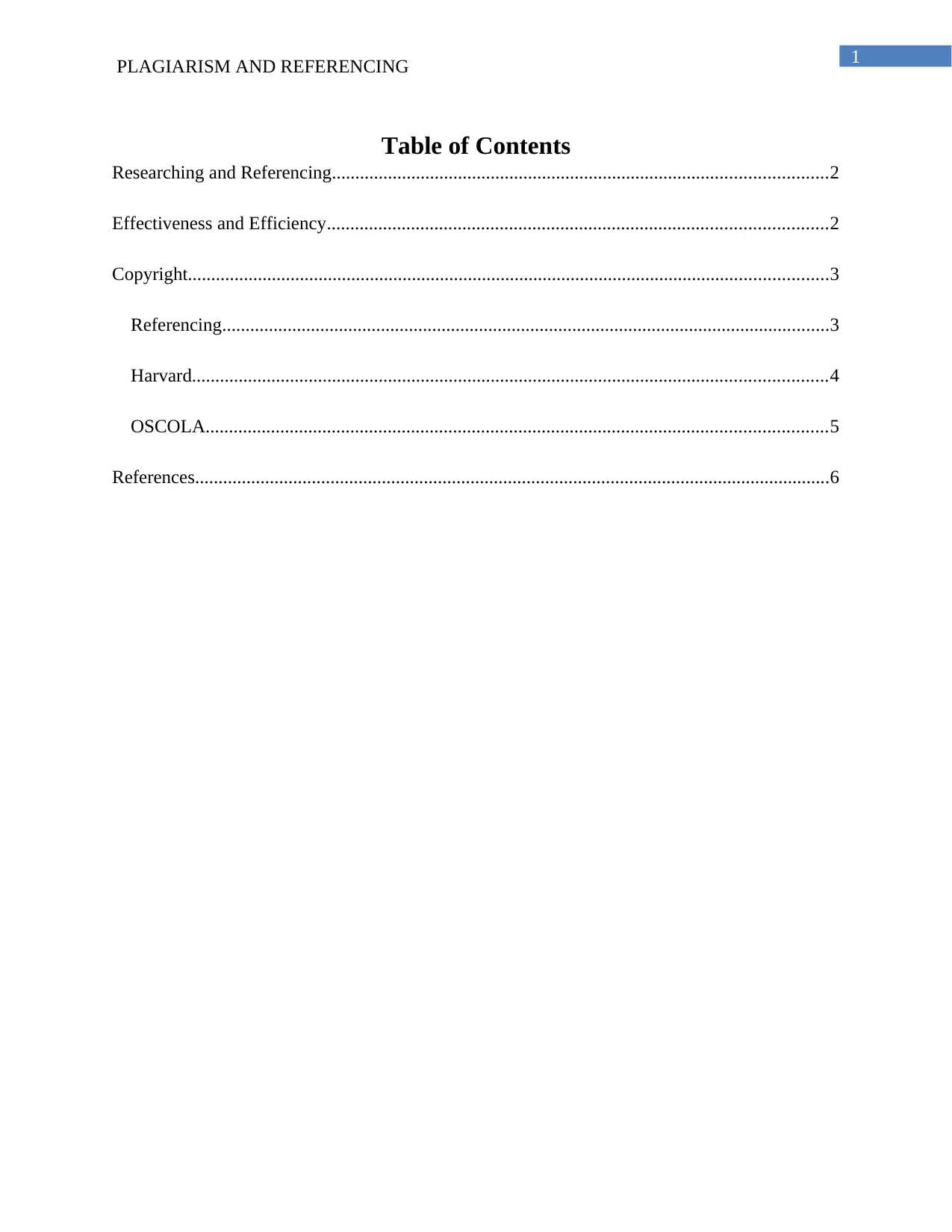
1
PLAGIARISM AND REFERENCING
Table of Contents
Researching and Referencing..........................................................................................................2
Effectiveness and Efficiency...........................................................................................................2
Copyright.........................................................................................................................................3
Referencing..................................................................................................................................3
Harvard........................................................................................................................................4
OSCOLA.....................................................................................................................................5
References........................................................................................................................................6
PLAGIARISM AND REFERENCING
Table of Contents
Researching and Referencing..........................................................................................................2
Effectiveness and Efficiency...........................................................................................................2
Copyright.........................................................................................................................................3
Referencing..................................................................................................................................3
Harvard........................................................................................................................................4
OSCOLA.....................................................................................................................................5
References........................................................................................................................................6
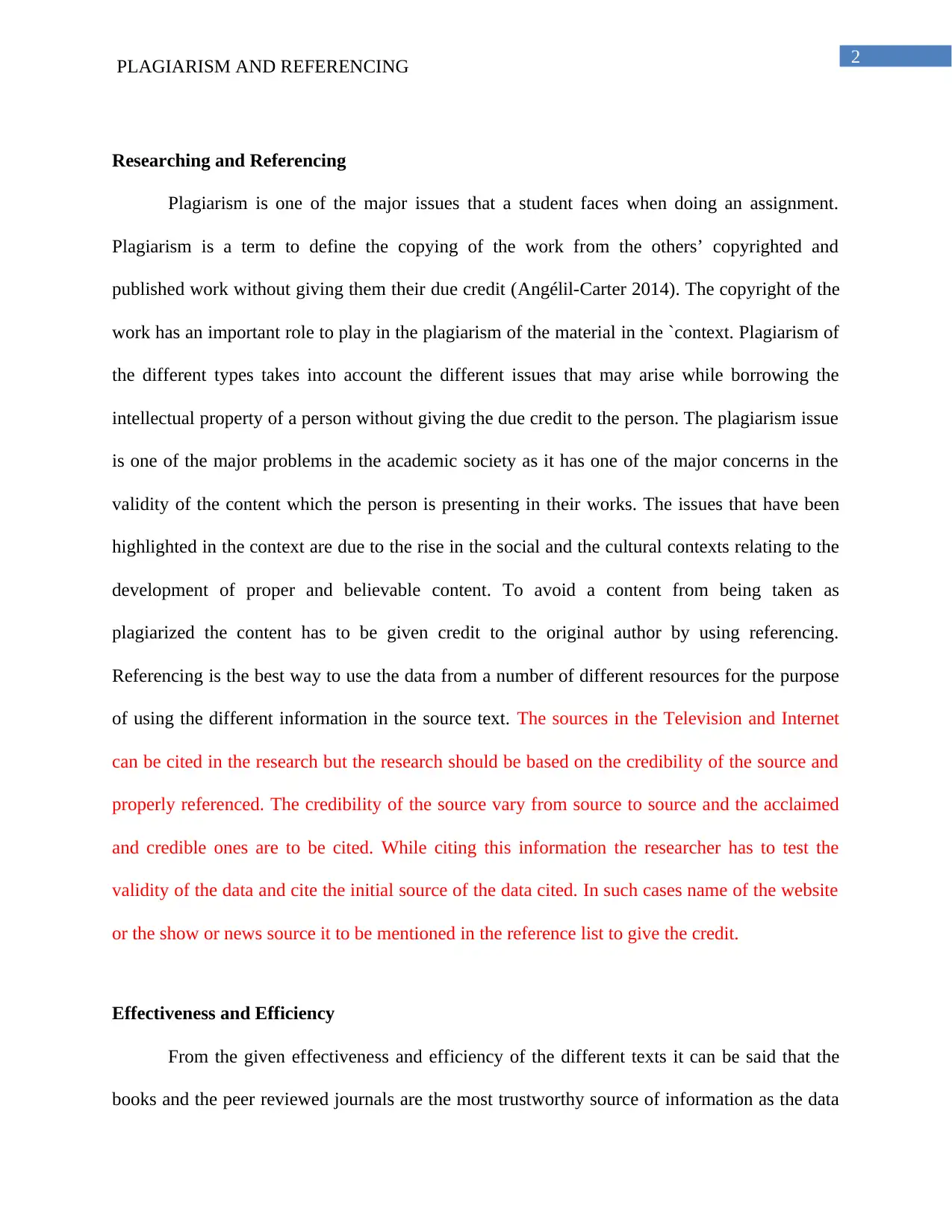
2
PLAGIARISM AND REFERENCING
Researching and Referencing
Plagiarism is one of the major issues that a student faces when doing an assignment.
Plagiarism is a term to define the copying of the work from the others’ copyrighted and
published work without giving them their due credit (Angélil-Carter 2014). The copyright of the
work has an important role to play in the plagiarism of the material in the `context. Plagiarism of
the different types takes into account the different issues that may arise while borrowing the
intellectual property of a person without giving the due credit to the person. The plagiarism issue
is one of the major problems in the academic society as it has one of the major concerns in the
validity of the content which the person is presenting in their works. The issues that have been
highlighted in the context are due to the rise in the social and the cultural contexts relating to the
development of proper and believable content. To avoid a content from being taken as
plagiarized the content has to be given credit to the original author by using referencing.
Referencing is the best way to use the data from a number of different resources for the purpose
of using the different information in the source text. The sources in the Television and Internet
can be cited in the research but the research should be based on the credibility of the source and
properly referenced. The credibility of the source vary from source to source and the acclaimed
and credible ones are to be cited. While citing this information the researcher has to test the
validity of the data and cite the initial source of the data cited. In such cases name of the website
or the show or news source it to be mentioned in the reference list to give the credit.
Effectiveness and Efficiency
From the given effectiveness and efficiency of the different texts it can be said that the
books and the peer reviewed journals are the most trustworthy source of information as the data
PLAGIARISM AND REFERENCING
Researching and Referencing
Plagiarism is one of the major issues that a student faces when doing an assignment.
Plagiarism is a term to define the copying of the work from the others’ copyrighted and
published work without giving them their due credit (Angélil-Carter 2014). The copyright of the
work has an important role to play in the plagiarism of the material in the `context. Plagiarism of
the different types takes into account the different issues that may arise while borrowing the
intellectual property of a person without giving the due credit to the person. The plagiarism issue
is one of the major problems in the academic society as it has one of the major concerns in the
validity of the content which the person is presenting in their works. The issues that have been
highlighted in the context are due to the rise in the social and the cultural contexts relating to the
development of proper and believable content. To avoid a content from being taken as
plagiarized the content has to be given credit to the original author by using referencing.
Referencing is the best way to use the data from a number of different resources for the purpose
of using the different information in the source text. The sources in the Television and Internet
can be cited in the research but the research should be based on the credibility of the source and
properly referenced. The credibility of the source vary from source to source and the acclaimed
and credible ones are to be cited. While citing this information the researcher has to test the
validity of the data and cite the initial source of the data cited. In such cases name of the website
or the show or news source it to be mentioned in the reference list to give the credit.
Effectiveness and Efficiency
From the given effectiveness and efficiency of the different texts it can be said that the
books and the peer reviewed journals are the most trustworthy source of information as the data
⊘ This is a preview!⊘
Do you want full access?
Subscribe today to unlock all pages.

Trusted by 1+ million students worldwide
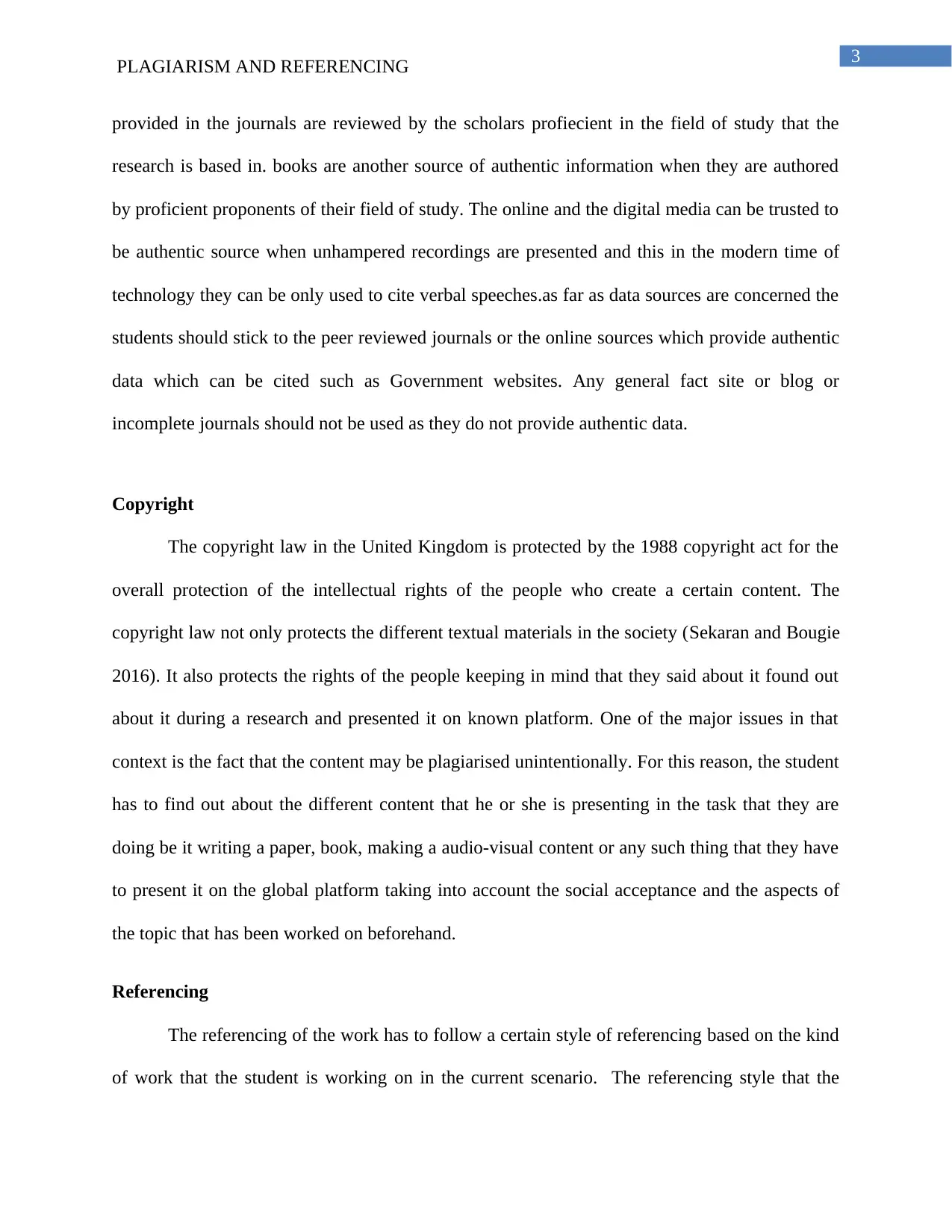
3
PLAGIARISM AND REFERENCING
provided in the journals are reviewed by the scholars profiecient in the field of study that the
research is based in. books are another source of authentic information when they are authored
by proficient proponents of their field of study. The online and the digital media can be trusted to
be authentic source when unhampered recordings are presented and this in the modern time of
technology they can be only used to cite verbal speeches.as far as data sources are concerned the
students should stick to the peer reviewed journals or the online sources which provide authentic
data which can be cited such as Government websites. Any general fact site or blog or
incomplete journals should not be used as they do not provide authentic data.
Copyright
The copyright law in the United Kingdom is protected by the 1988 copyright act for the
overall protection of the intellectual rights of the people who create a certain content. The
copyright law not only protects the different textual materials in the society (Sekaran and Bougie
2016). It also protects the rights of the people keeping in mind that they said about it found out
about it during a research and presented it on known platform. One of the major issues in that
context is the fact that the content may be plagiarised unintentionally. For this reason, the student
has to find out about the different content that he or she is presenting in the task that they are
doing be it writing a paper, book, making a audio-visual content or any such thing that they have
to present it on the global platform taking into account the social acceptance and the aspects of
the topic that has been worked on beforehand.
Referencing
The referencing of the work has to follow a certain style of referencing based on the kind
of work that the student is working on in the current scenario. The referencing style that the
PLAGIARISM AND REFERENCING
provided in the journals are reviewed by the scholars profiecient in the field of study that the
research is based in. books are another source of authentic information when they are authored
by proficient proponents of their field of study. The online and the digital media can be trusted to
be authentic source when unhampered recordings are presented and this in the modern time of
technology they can be only used to cite verbal speeches.as far as data sources are concerned the
students should stick to the peer reviewed journals or the online sources which provide authentic
data which can be cited such as Government websites. Any general fact site or blog or
incomplete journals should not be used as they do not provide authentic data.
Copyright
The copyright law in the United Kingdom is protected by the 1988 copyright act for the
overall protection of the intellectual rights of the people who create a certain content. The
copyright law not only protects the different textual materials in the society (Sekaran and Bougie
2016). It also protects the rights of the people keeping in mind that they said about it found out
about it during a research and presented it on known platform. One of the major issues in that
context is the fact that the content may be plagiarised unintentionally. For this reason, the student
has to find out about the different content that he or she is presenting in the task that they are
doing be it writing a paper, book, making a audio-visual content or any such thing that they have
to present it on the global platform taking into account the social acceptance and the aspects of
the topic that has been worked on beforehand.
Referencing
The referencing of the work has to follow a certain style of referencing based on the kind
of work that the student is working on in the current scenario. The referencing style that the
Paraphrase This Document
Need a fresh take? Get an instant paraphrase of this document with our AI Paraphraser
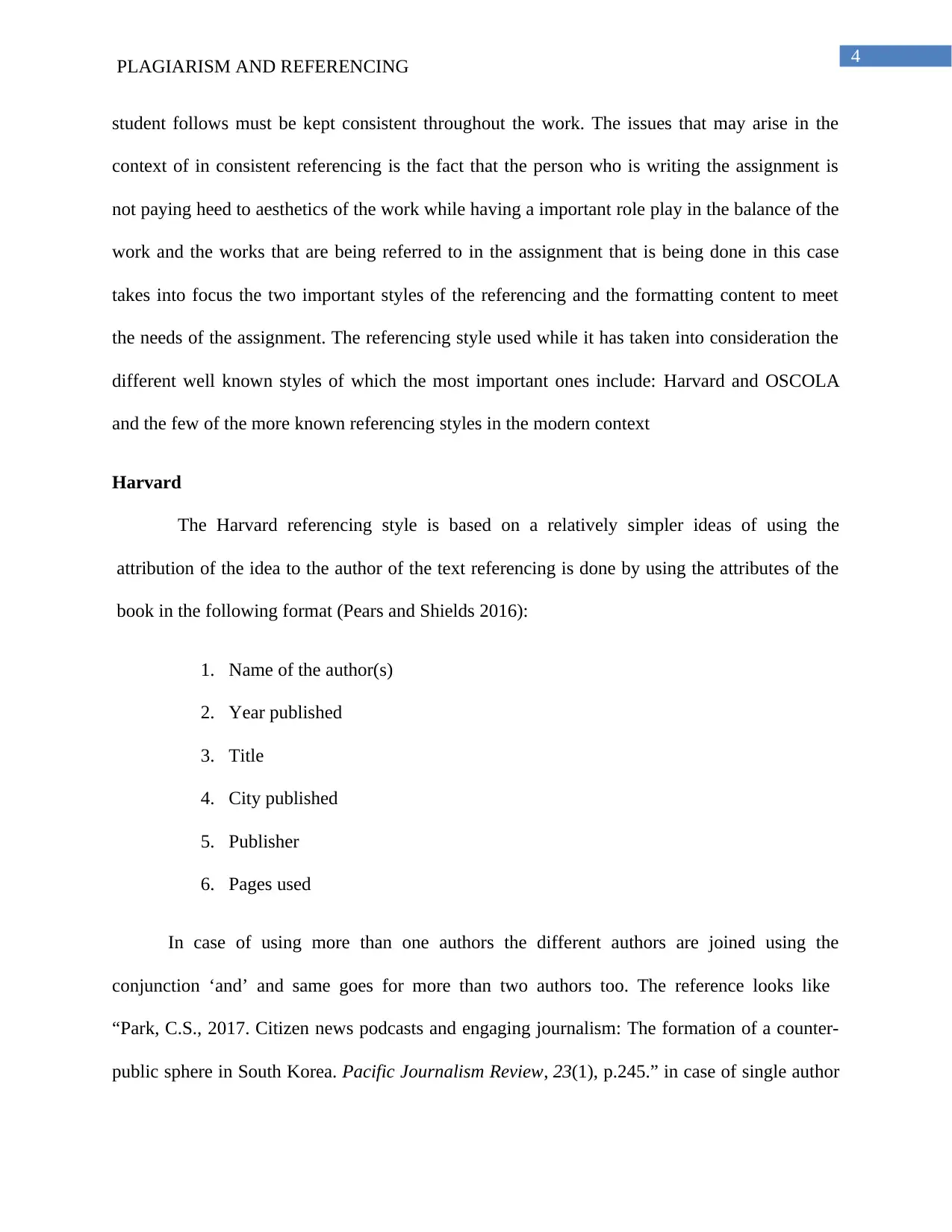
4
PLAGIARISM AND REFERENCING
student follows must be kept consistent throughout the work. The issues that may arise in the
context of in consistent referencing is the fact that the person who is writing the assignment is
not paying heed to aesthetics of the work while having a important role play in the balance of the
work and the works that are being referred to in the assignment that is being done in this case
takes into focus the two important styles of the referencing and the formatting content to meet
the needs of the assignment. The referencing style used while it has taken into consideration the
different well known styles of which the most important ones include: Harvard and OSCOLA
and the few of the more known referencing styles in the modern context
Harvard
The Harvard referencing style is based on a relatively simpler ideas of using the
attribution of the idea to the author of the text referencing is done by using the attributes of the
book in the following format (Pears and Shields 2016):
1. Name of the author(s)
2. Year published
3. Title
4. City published
5. Publisher
6. Pages used
In case of using more than one authors the different authors are joined using the
conjunction ‘and’ and same goes for more than two authors too. The reference looks like
“Park, C.S., 2017. Citizen news podcasts and engaging journalism: The formation of a counter-
public sphere in South Korea. Pacific Journalism Review, 23(1), p.245.” in case of single author
PLAGIARISM AND REFERENCING
student follows must be kept consistent throughout the work. The issues that may arise in the
context of in consistent referencing is the fact that the person who is writing the assignment is
not paying heed to aesthetics of the work while having a important role play in the balance of the
work and the works that are being referred to in the assignment that is being done in this case
takes into focus the two important styles of the referencing and the formatting content to meet
the needs of the assignment. The referencing style used while it has taken into consideration the
different well known styles of which the most important ones include: Harvard and OSCOLA
and the few of the more known referencing styles in the modern context
Harvard
The Harvard referencing style is based on a relatively simpler ideas of using the
attribution of the idea to the author of the text referencing is done by using the attributes of the
book in the following format (Pears and Shields 2016):
1. Name of the author(s)
2. Year published
3. Title
4. City published
5. Publisher
6. Pages used
In case of using more than one authors the different authors are joined using the
conjunction ‘and’ and same goes for more than two authors too. The reference looks like
“Park, C.S., 2017. Citizen news podcasts and engaging journalism: The formation of a counter-
public sphere in South Korea. Pacific Journalism Review, 23(1), p.245.” in case of single author
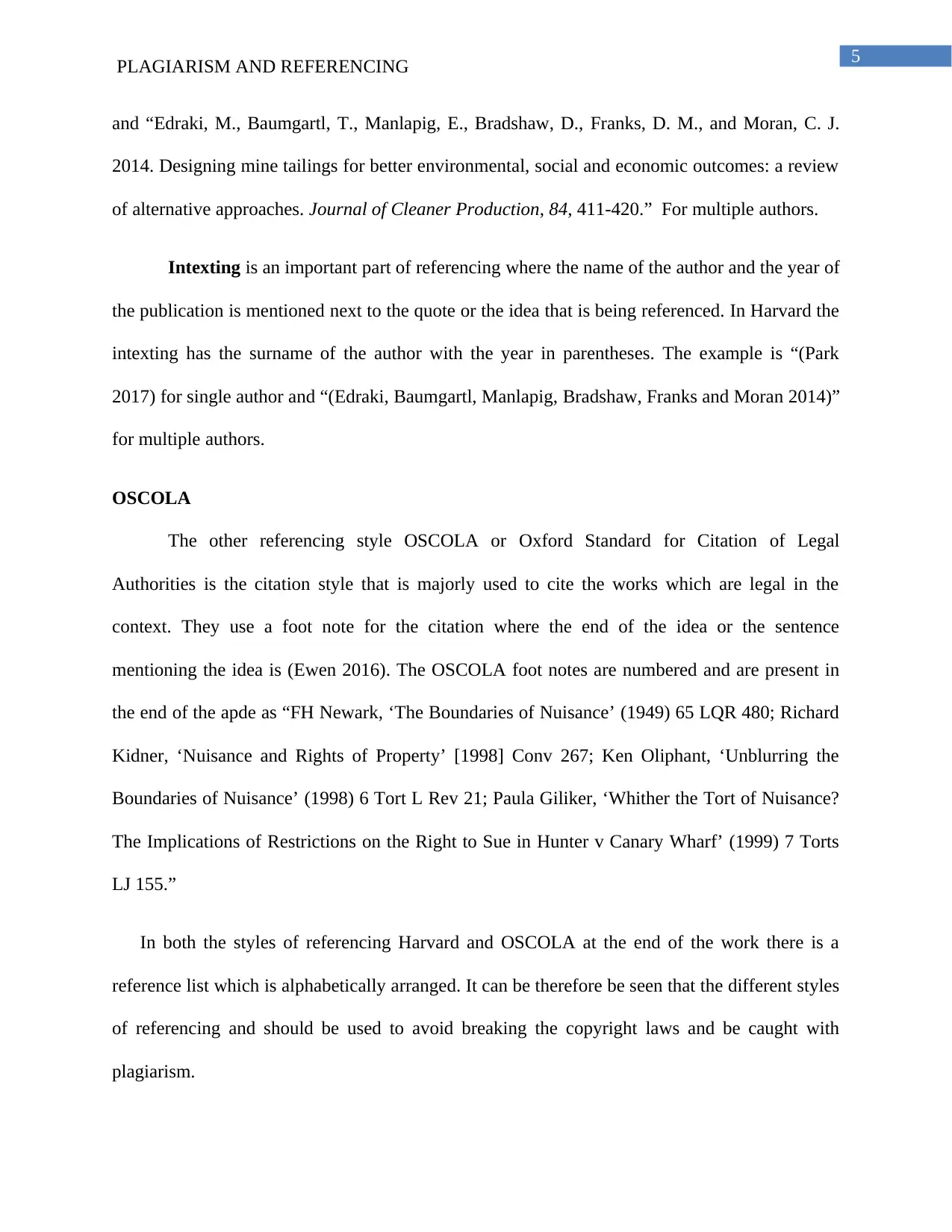
5
PLAGIARISM AND REFERENCING
and “Edraki, M., Baumgartl, T., Manlapig, E., Bradshaw, D., Franks, D. M., and Moran, C. J.
2014. Designing mine tailings for better environmental, social and economic outcomes: a review
of alternative approaches. Journal of Cleaner Production, 84, 411-420.” For multiple authors.
Intexting is an important part of referencing where the name of the author and the year of
the publication is mentioned next to the quote or the idea that is being referenced. In Harvard the
intexting has the surname of the author with the year in parentheses. The example is “(Park
2017) for single author and “(Edraki, Baumgartl, Manlapig, Bradshaw, Franks and Moran 2014)”
for multiple authors.
OSCOLA
The other referencing style OSCOLA or Oxford Standard for Citation of Legal
Authorities is the citation style that is majorly used to cite the works which are legal in the
context. They use a foot note for the citation where the end of the idea or the sentence
mentioning the idea is (Ewen 2016). The OSCOLA foot notes are numbered and are present in
the end of the apde as “FH Newark, ‘The Boundaries of Nuisance’ (1949) 65 LQR 480; Richard
Kidner, ‘Nuisance and Rights of Property’ [1998] Conv 267; Ken Oliphant, ‘Unblurring the
Boundaries of Nuisance’ (1998) 6 Tort L Rev 21; Paula Giliker, ‘Whither the Tort of Nuisance?
The Implications of Restrictions on the Right to Sue in Hunter v Canary Wharf’ (1999) 7 Torts
LJ 155.”
In both the styles of referencing Harvard and OSCOLA at the end of the work there is a
reference list which is alphabetically arranged. It can be therefore be seen that the different styles
of referencing and should be used to avoid breaking the copyright laws and be caught with
plagiarism.
PLAGIARISM AND REFERENCING
and “Edraki, M., Baumgartl, T., Manlapig, E., Bradshaw, D., Franks, D. M., and Moran, C. J.
2014. Designing mine tailings for better environmental, social and economic outcomes: a review
of alternative approaches. Journal of Cleaner Production, 84, 411-420.” For multiple authors.
Intexting is an important part of referencing where the name of the author and the year of
the publication is mentioned next to the quote or the idea that is being referenced. In Harvard the
intexting has the surname of the author with the year in parentheses. The example is “(Park
2017) for single author and “(Edraki, Baumgartl, Manlapig, Bradshaw, Franks and Moran 2014)”
for multiple authors.
OSCOLA
The other referencing style OSCOLA or Oxford Standard for Citation of Legal
Authorities is the citation style that is majorly used to cite the works which are legal in the
context. They use a foot note for the citation where the end of the idea or the sentence
mentioning the idea is (Ewen 2016). The OSCOLA foot notes are numbered and are present in
the end of the apde as “FH Newark, ‘The Boundaries of Nuisance’ (1949) 65 LQR 480; Richard
Kidner, ‘Nuisance and Rights of Property’ [1998] Conv 267; Ken Oliphant, ‘Unblurring the
Boundaries of Nuisance’ (1998) 6 Tort L Rev 21; Paula Giliker, ‘Whither the Tort of Nuisance?
The Implications of Restrictions on the Right to Sue in Hunter v Canary Wharf’ (1999) 7 Torts
LJ 155.”
In both the styles of referencing Harvard and OSCOLA at the end of the work there is a
reference list which is alphabetically arranged. It can be therefore be seen that the different styles
of referencing and should be used to avoid breaking the copyright laws and be caught with
plagiarism.
⊘ This is a preview!⊘
Do you want full access?
Subscribe today to unlock all pages.

Trusted by 1+ million students worldwide
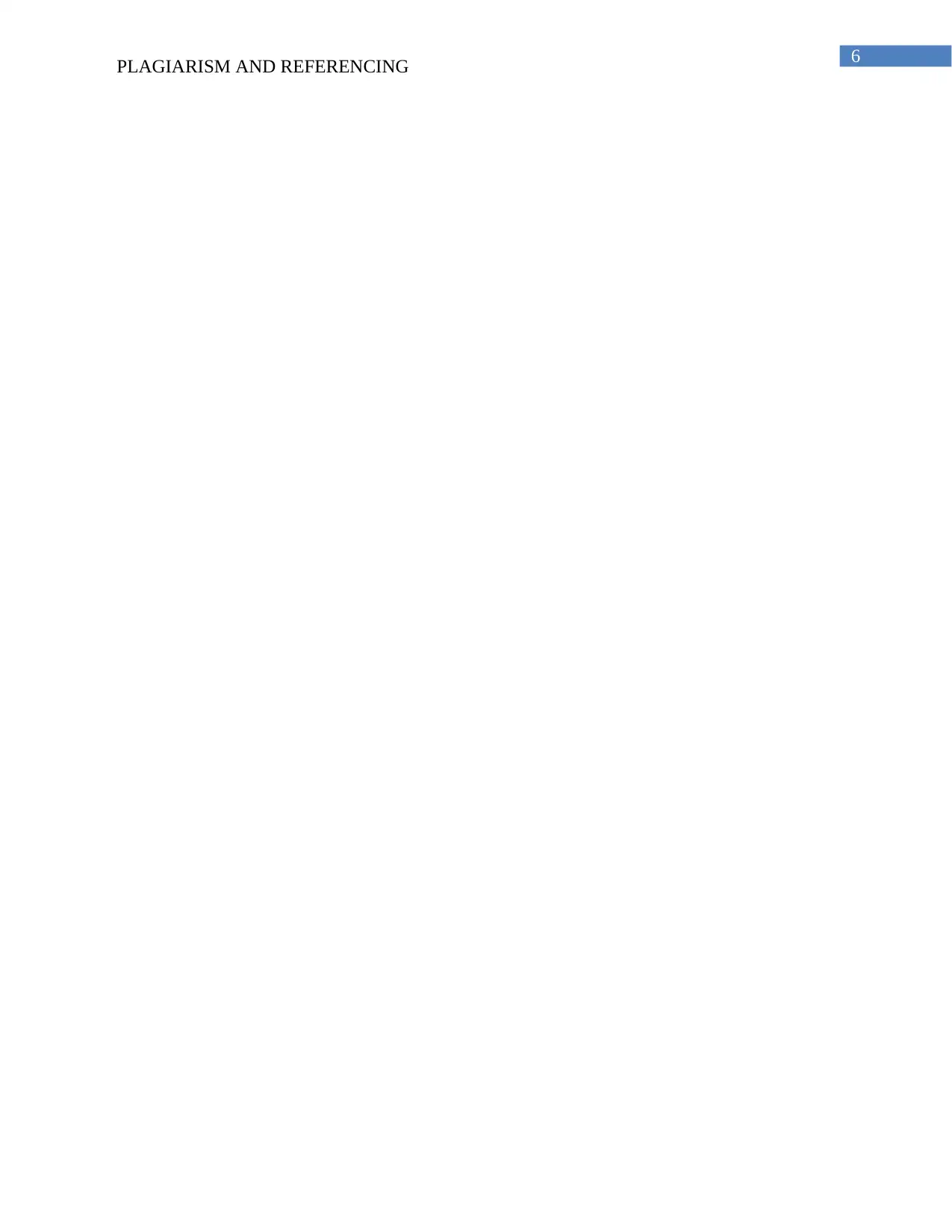
6
PLAGIARISM AND REFERENCING
PLAGIARISM AND REFERENCING
Paraphrase This Document
Need a fresh take? Get an instant paraphrase of this document with our AI Paraphraser
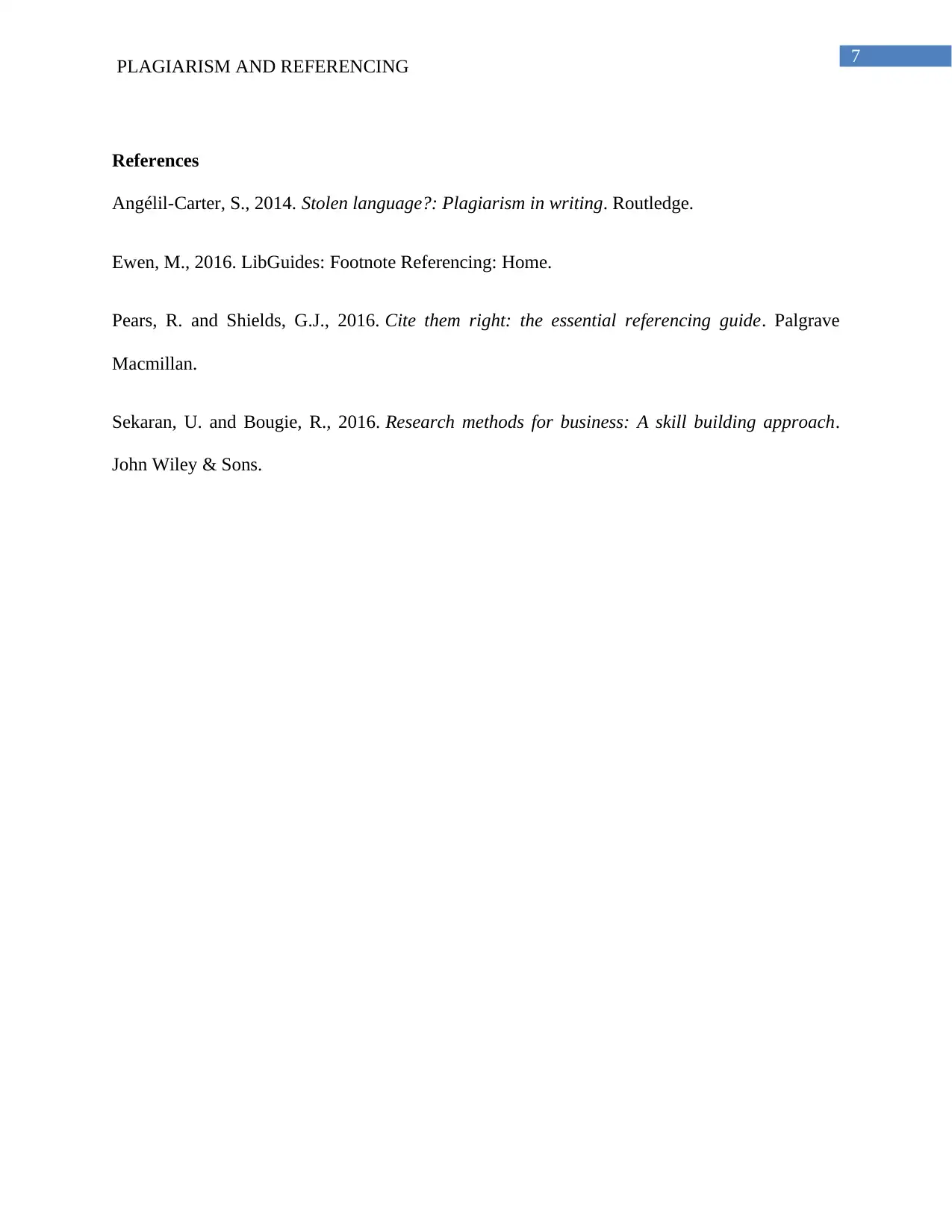
7
PLAGIARISM AND REFERENCING
References
Angélil-Carter, S., 2014. Stolen language?: Plagiarism in writing. Routledge.
Ewen, M., 2016. LibGuides: Footnote Referencing: Home.
Pears, R. and Shields, G.J., 2016. Cite them right: the essential referencing guide. Palgrave
Macmillan.
Sekaran, U. and Bougie, R., 2016. Research methods for business: A skill building approach.
John Wiley & Sons.
PLAGIARISM AND REFERENCING
References
Angélil-Carter, S., 2014. Stolen language?: Plagiarism in writing. Routledge.
Ewen, M., 2016. LibGuides: Footnote Referencing: Home.
Pears, R. and Shields, G.J., 2016. Cite them right: the essential referencing guide. Palgrave
Macmillan.
Sekaran, U. and Bougie, R., 2016. Research methods for business: A skill building approach.
John Wiley & Sons.
1 out of 8
Related Documents
Your All-in-One AI-Powered Toolkit for Academic Success.
+13062052269
info@desklib.com
Available 24*7 on WhatsApp / Email
![[object Object]](/_next/static/media/star-bottom.7253800d.svg)
Unlock your academic potential
Copyright © 2020–2025 A2Z Services. All Rights Reserved. Developed and managed by ZUCOL.





